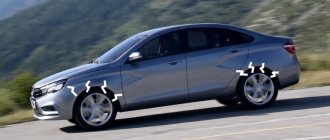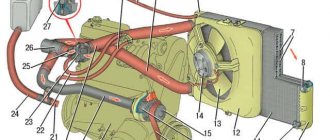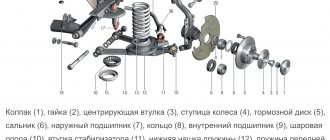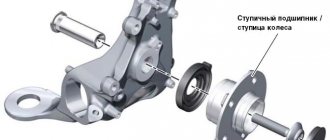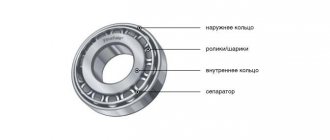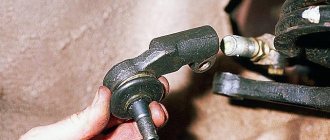Suspension or steering
A knock on small bumps does not always indicate a breakdown in the suspension. Similar sounds may come from the steering. You need to check the suspension and steering rack.
When this mechanism is faulty, vibration on the steering wheel is noticeable when driving on uneven roads. A large gap appears between the rack and gear, increasing over time, and vibration also increases. To get rid of the problem, you need to tighten the rail.
The problem may be related to the bushings on the tie rods. The parts need to be swung individually with a pry bar. If there is significant play, the element should be replaced.
If after tightening the rack and replacing the bushings the problem remains, you need to check the steering joint. For diagnostics, 2 people are needed: one must fix the hinge, body and pin, and the other must turn the steering wheel sharply at a small angle. If there is play, it will become clear that the mechanism requires replacement.
It is worth checking the steering rack ends. A sign of wear - a characteristic sound appears when the steering wheel is rotated while driving at a small angle, play is noticeable. The tips cannot be repaired; only replacement will help.
If the knock remains after the work, a full suspension diagnosis is required.
Front suspension diagram
When do the supports knock?
If you hear a dull knock on the left or right when driving over potholes, bumps and other uneven surfaces, the cause may be wear on the shock absorber strut support.
It is a rubber damper gasket through which the load from the shock absorber is transferred to the body. Over time, the rubber wears out and loses its elasticity, which leads to knocking noises. To make sure that the diagnosis is correct, you need to measure the gap between the support and the stop plate. It should be within 8-10 mm. If the gap is increased, the support must be changed. It must be said that access to the support is usually difficult. To dismantle it, you need to release the upper part of the shock absorber, as, for example, on a VAZ Kalina car (below in the photo).
Sometimes the struts in the car knock, i.e. shock absorbers. Knocks usually appear when driving over bumps, as well as when entering a turn, when the load falls on a damaged shock absorber. Since shock absorbers rarely fail in pairs, the knocking noise occurs only on one side. To make sure that the shock absorber has failed, you need to put all your weight on the wing. When the car “sags” on the side of the wheel, release it sharply. If the body returns to its original position without rocking, then the shock absorber is working. If the body swings up/down for some time, then the shock absorber needs to be replaced.
Another reason for knocking is wear of the support bearing. This malfunction can be identified by a louder sound that is heard when driving on a straight road. When turning, the sound disappears, but vibration may be felt in the steering wheel. In some cars, such as Renault Logan, the bearing is located close to the hood, so the fault can be determined even when the car is stationary. To do this, you just need to open the hood, start rocking the car from side to side and listen to the support. If you hear crunching and knocking noises, then the problem is in the bearing.
To visually assess the condition of the bearing and replace it, it is necessary to dismantle the shock absorber strut and support.
Sometimes a knocking noise occurs due to a loose support nut. Therefore, first of all, tighten the nut and check if the knocking noise has disappeared.
Stabilizer bushings
It is difficult to determine the breakdown of elements by sound. In order not to change the part, you need to check the bushing by hand. This can be done by a mechanic at a service station.
The malfunction can easily be confused with failed silent blocks. The difference is that if the bushings are installed on a subframe, the driver will feel vibration in his legs while driving.
Attention! It is impossible to check and replace the bushings on a lift; you need an inspection hole or platform so that the load is applied to the wheels.
If the parts are faulty, vibration will occur on any bumps.
Stabilizer's pole
The part is used to attach the stabilizer to the suspension. If there is a malfunction, the chassis begins to knock loudly. Knocks can be accompanied by strong car rolls when cornering, during acceleration and braking; it is necessary to constantly steer.
The breakdown occurs due to the anthers becoming unusable, moisture and dirt getting into the mechanism, and wear occurs.
To check the stabilizer links, you need to rock a stationary car. If this happens easily and with a knock, the part is faulty.
Another way to check is to turn the wheel and pull the rods. If there are gaps, it’s time to change the racks. Work should be done on a pit or platform for convenience.
It is important to check the anthers. If the mechanisms are torn, and there is moisture inside and there is no lubrication, it’s time to change the rack.
It is recommended to purchase a new part and replace it.
Checking silent blocks
Car suspensions contain levers whose structure contains silent blocks. Elements are necessary for attaching shock absorbers.
Over time, the part wears out and cannot fulfill its role. “Rolling” appears and the car handles worse. When the silent block becomes unusable, play occurs.
To check the part you need a jack and a pry bar. Necessary:
- Raise the car so that the wheel is hanging out.
- Using a pry bar, loosen the suspension arms, checking for play.
If there is a gap and is accompanied by knocking noises, the part is faulty and needs replacement. It is necessary to check both silent blocks.
Attention! The parts wear out evenly, it is recommended to change them together, even if one does not play.
The process is simple: you need to remove the levers and dismantle the silent blocks. You will need a special tool.
The appearance of malfunctions in the engine mount
In order to detect problems in the condition of the motor support, it will be enough to conduct only a visual external inspection. At a high level of wear of this element, you will find the appearance of significant tears, as indicated in the photo below.
The broken support is shown on the left, and the new support is shown on the right. As a rule, problems with the engine mount can occur after 100 thousand km of the vehicle. In addition, noise in the supports may be accompanied by vibration of the engine itself. In this case, you may find black carbon deposits on the spark plugs. To determine the specific cause of knocking and shaking, conduct a detailed diagnosis of all vehicle systems.
Advice: remember - timely repairs (even if there is slight noise on small bumps, holes and uneven surfaces) will guarantee the durability of the car's front suspension in the future.
Spherical bearing
The front suspension of passenger cars has 2 ball joints - one for each wheel. signs of malfunction:
- The steering wheel turns harder.
- Knocks are heard in the front suspension when driving.
- Controllability deteriorates, the wheels “float”.
- The rubber tread wears off intensively.
- Wheel alignment is not displayed.
You can determine if the ball joints are faulty by diagnostics: hang the car wheel with a jack or on a lift, hold down the brake pedal, and turn the wheel from the outside. The procedure must be carried out together.
If, during a sharp turn, play appears, accompanied by a knocking sound, an urgent replacement of the ball joints is necessary. The anthers should be checked. The parts must be intact, otherwise they will become unusable.
Knocking in the suspension when driving on bumps and uneven surfaces: Causes and consequences
The first place to start inspecting a car is with the levers. As soon as some defect occurs in the latter, the suspension begins to knock. Among the most common defects is wear of rubber-metal hinges (silent blocks). If the steering wheel begins to oscillate while driving, this can lead to deterioration in the car’s controllability, and at high speeds such a problem can even lead to a run off the road, so there is no point in wasting time checking and repairing it. In order to identify the wear of the rubber-metal hinges, you just need to shake the ends of the rods with a mounting tool. The problem in silent blocks can be eliminated by replacing them.
When checking the car, attention should also be paid to the tie rod ends. A knock may occur due to large play in the finger in the socket. Play in this area can be detected in another way, simply by shaking the steering wheel from side to side.
A knock in the front suspension can also occur due to ball joints that may have worn out a long time ago. You can get rid of such a knock only by completely replacing the worn part. The main task assigned to the ball joints is to turn the steered wheels. This part takes on the maximum load that appears on a poor-quality road surface. You cannot delay replacing ball joints - the longer you delay, the greater the likelihood that they will tear out and the vehicle will immediately lose control.
When inspecting the front suspension, look at the condition of the steering wheel caps and supports. The purpose of such covers is to protect the hinge from contamination. If the protection is defective and dirt gets on it, this will greatly reduce the service life of the part.
Often the cause of a knock can be a failed shock absorber, which often becomes unusable due to improper use, as well as in cases where the car is operated in difficult conditions. You can understand the condition of the shock absorbers on uneven roads. If after a bump the car rocks in all directions, then there is a problem with the shock absorbers.
You can also check the condition of the shock absorber after removing it from the car. After dismantling, the part is installed in a vertical position, and then the rod is pulled out/lowered several times. If, when moving the rod upward, less resistance is felt than when the same manipulations are performed in the opposite direction, this indicates a malfunction of the shock absorber. If the rod moves too freely, then there is a lack of working fluid.
If you notice a knocking sound in the suspension of your car, do not hesitate and take the necessary measures immediately. If you cannot carry out repairs yourself or doubt your abilities, contact professionals. By the way, even if the suspension does not bother you, experts strongly recommend checking its condition about twice a year.
If you liked it, please share with your friends!
Wheel bearings
The initial stage of breakdown is accompanied by a hum. To make sure that the wheel bearings are faulty, you need to accelerate the car to 50 km/h and perform the “snake” exercise, turning the steering wheel slightly. If you hear a hum, the parts are broken. On which side the sound is stronger, on that side the part is worn out more.
Diagnostics is possible using special equipment, or you can perform the procedure yourself. Necessary:
- Raise the front axle of the car.
- Grab the wheel from above and below with your hands.
- Try tilting.
If the bearing is good, the wheel will be fixed and will not move. The presence of play means the part has become unusable. The problem may arise from the steering rack.
Attention! For vehicles with a front drive axle, the wheels are checked vertically and horizontally.
You cannot continue operating the machine with faulty bearings. The breakdown must be repaired, otherwise the mechanism may suddenly jam.
Signs of bad wheel bearings
Balloons are no joke
The cause of knocks and squeaks is often wear and tear on the ball joints. This is a very important part in the form of a hinge that connects the wheel hub to the suspension arm. True, ball joints usually knock only on rear-wheel drive cars with a simple suspension. On front-wheel drive vehicles, the malfunction manifests itself in the form of a squeaking sound. The exception is cases when wear reaches a critical value, i.e. the hinge begins to simply dangle in the body.
To verify that the ball joint is faulty, you need to hang the wheel, press the brake pedal and try to turn the wheel left and right. If there is play and knocking, then the ball needs to be changed. It must be said that in some cars, such as the Lada Granta or VAZ 2110, the ball joint is bolted on, so replacing it is not difficult. But sometimes there are supports that are pressed into the lever (Mercedes CLS W219 or SsangYong Rexton). Accordingly, they are replaced along with the lever, even if it is still in good condition.
If no play is detected, you need to check the condition of the boot. The fact is that often the cause of noise in ball joints is dirt getting under the joint. Therefore, you need to add lubricant to the hinge and replace the boot.
A rupture of the ball joint (tearing out the hinge from the body) can cause an accident, since in this case the wheel turns out and the car falls on the asphalt. Therefore, when the first signs of wear appear, it must be changed.
Brake problems
If a knocking noise occurs when you press or lower the brake pedal, there is a problem with the ABS (anti-lock braking system). This nuance arises after repair work was performed incorrectly.
Brake problems:
- Damage to the seats for the caliper guides, which is loose and vibrates. Parts need to be replaced.
- Caliper piston jamming. The element hits the pads sharply, causing a knocking sound. The piston changes.
- Brake disc guidance. Due to high temperatures, the part may change shape and bend. The pads begin to wear unevenly. You need to check the disk on special equipment in order to replace it in time.
- The pad retainer has come off and will hit the drum, creating a knocking sound. The part needs to be installed in place and the cause of the jumping off must be determined.
The problem is related to a malfunction in the ABS. It is enough to remove the corresponding fuse from the block. If after carrying out the actions the knocking stops, the ABS is faulty. Specialists can fix the problem; there is no need to try to fix it yourself.
Problems with the rack supports
The upper parts of the supports suffer the most when driving on uneven roads. In this case, most often it is necessary to replace the rubber base, which is necessary to dampen vibration and the resulting excess noise. The sound occurs as a result of loss of flexibility and severe wear of the base.
Often, when sounds appear, the driver begins to manually sort out the entire front suspension, spending a lot of time and money on new spare parts, but the cause of the noise does not disappear. You can identify the presence of a problem in the rubber base by simply measuring the gap distance between the support structure and the plastic stop. On average, the value of this parameter should be 8-10 mm.
To replace the rubberized base, contact a car service center - here they will carefully remove the support and install a new layer of rubber. In this case, noise and vibration will go away immediately, and the new “layer” will last another 20-40 thousand km.
Engine support cushions
The pillows contain rubber elements that wear out over time. Because of this, the car rattles when driving.
You need to open the hood and start the engine. Strong vibration indicates that the parts have become unusable. If the engine shakes or tilts more when you press the gas, it's time to change the elements.
You can check the integrity of the pillows yourself without visually. You need to try to shake the power unit. If the action can be performed without effort, it’s time to change the pillows.
You should not ignore such a breakdown; due to the force of vibration, various components are destroyed. When the part becomes unusable, the motor breaks off its mounts, and serious repairs will be required.
You can change the pillows yourself. Without work experience, you should contact the experts.
